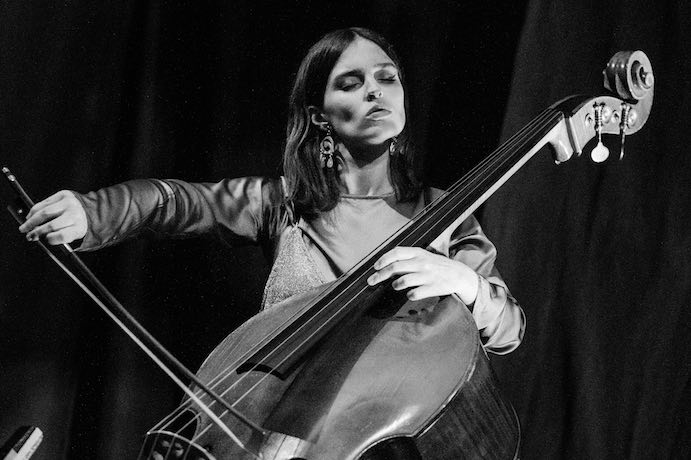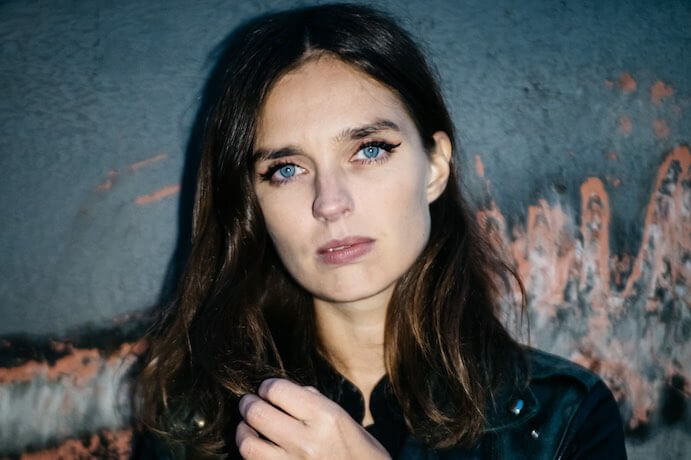CW: this interview mentions suicide
Icelandic composer and double-bassist Bára Gísladóttir recently released her solo album, HĪBER, for bass and electronics on Dacapo Records. Currently based in Copenhagen, Bára’s music has been featured all over the U.S. and Europe through a variety of ensembles and festivals, from the Danish National Symphony Orchestra to Ensemble InterContemporain. Gísladóttir describes HĪBER as “an exploration of texture and darkness where core serves as a common thread.” HĪBER, a title that stems from hībernus, refers to the idea of getting through the long winters and ideas of hibernation. Each of the movements on the album has an evocative title, either as a root word or as a self-referential phrase, and the double bass and electronics swirl and blend in an ethereal array of overtones, scrapes, and textural explorations.
First of all, congratulations on HĪBER! This is a truly beautiful album in the way the bass and the electronics intermingle. How did you create the concept for the album?
Thank you so much. HĪBER is spun out of the idea of a winter or hibernation period lasting more than one semester. What I had in mind was a hibernation where time was in slow motion or even frozen. I think a lot about form and texture in my work, and for HĪBER, I worked with the concept of the frozen time/timelessness personified by an abstract cold figure of various shades of green whose texture was deep and dense, but elastic and viscous. Perhaps a little bit like layers of moss soaking in oil.

On your website, you mention that HĪBER is “divided in eight parts” and that “each piece is approached with various definitions and angles.” Could you talk more about the angles you envision?
In my work, I like to approach every idea from every possible point of view. For instance, a single word can mean or refer to various aspects, so I try to use all aspects as contributors to the piece or concept I’m working on. By doing so, I feel that I’m able to create further dimensions in my music.
Each of your movements has a seemingly programmatic title. Could you describe your approach to the music and how you chose the movement titles?
When I was working on HĪBER, I had outlined all the titles and their various aspects before I started making the actual music. This is something I commonly do. I don’t really see it as compositional preparation; but rather as an equally important part of the creative process as the audible material.
When choosing the different titles, I worked with Latin word stems on the one hand and small sequences on the other, creating a counterpoint between the two groups. Each title is a contribution to the hibernation of what may seem like an everlasting winter.
I. SUĪ
SUĪ can refer to each other, one another, him/her/it/oneself. It can also be placed with other word cores as in suīcīdium (suicide). I think there can exist a link between suicidal thoughts and a wish for an everlasting hibernation, so this track is perhaps the one that deals with hibernation at its longest and/or most intense.
II. VĒXŌ
VĒXŌ simply means ‘I shake,’ but the movement itself also portrays a general quake. In HĪBER, it serves as a contributor to the thought of a hibernation in intense movement.
III. no afterlife thanks
Well, if one wishes for a hibernation in the first place, an afterlife perhaps does not seem necessary.
IV. her palms faced down forever after
The thought of hibernating with palms facing down.
V. tvíhirta
This part of HĪBER explores the concept’s physical form rather than the ideas of hibernation’s different states. The word ‘tvíhirta’ may sound Icelandic, but it is sort of a made up word. Tví meaning ‘two of something’ and hirta reminding of ‘hjarta’ (heart). Somehow, I also related hirta to ‘flétta’ (braid), which does not really make much sense at all, but it is important in order to understand the content of the movement itself. “Tvíhirta” deals with the concept of an organism having two hearts, but perhaps not naturally, much rather the idea of a body being (even unwillingly) given an extra heart with a somewhat horrific transplant.
VI. cusp day
This movement is based on the idea of a cusp or a void, and if such concepts really exists (and not in a man-made way). “cusp day” is about the condition of a being inbetween things, or perhaps not between anything at all. It refers to the sort of timeless/endless aspect of HĪBER.
VII. GRAVIS
GRAVIS refers to something heavy, serious, troublesome, or hard. I like to look at it as a general interpretation of the concept behind HĪBER, it touches on all the ideas behind the album.
VIII. fists clenched
Although sounding aggressive (and it certainly is), this track above all deals with the thought of sleeping or hibernating with ones fists tightly clenched.
You certainly are at ease with electronics in your composition. What is the role of the electronics in the music and in your process?
I like to look at the electronics as an extension of a core rather than additional material, so a little bit like branches growing from a stem. Most of the time, my goal is to intertwine acoustics and electronics in a way where it’s quasi impossible to make out which is which.

How do you place HĪBER in the context of the rest of your work?
As with most of my work, HĪBER is a braid of thoroughly recycled material. It is perhaps an even calmer and more fearless exploration of darkness than I’ve experimented with so far. A helpful factor was the absence of needing to rush when it came to finishing the music (since initially, I had no plans on releasing it), so I was able to work on it for over three years. I also allowed myself to take more liberty when it came to the use of electronics than I had before. Most of the time, I work with the aftermath of sound myself, but this time I asked my good friend and long time collaborator Skúli Sverrisson to mix HĪBER. He really did an astonishing job and somehow managed to bring forth the essential texture, nuances, and mass of the music.
I CARE IF YOU LISTEN is a program of the American Composers Forum, funded with generous donor and institutional support. A gift to ACF helps support the work of ICIYL. Editorial decisions are made at the sole discretion of the editor-in-chief. For more on ACF, visit the “At ACF” section or composersforum.org.
























